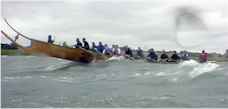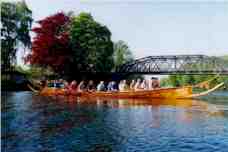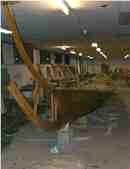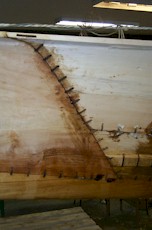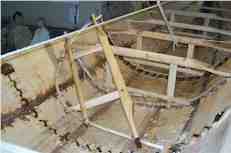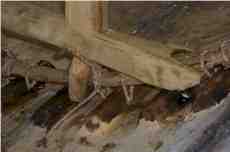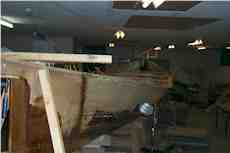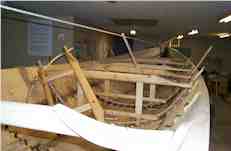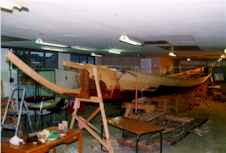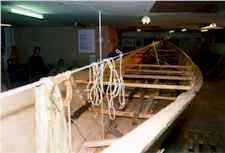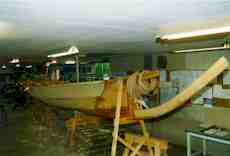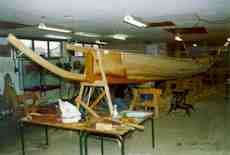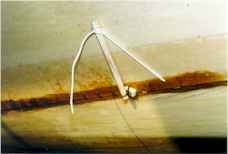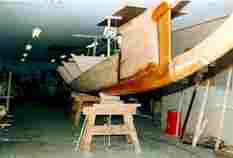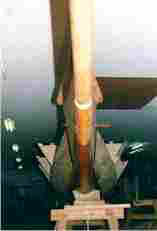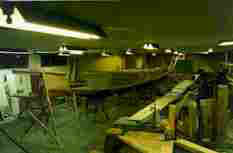What happens at the Shipyard ?
2000
2000-09-03: Tilia on Als Fjord.
picture, courtesy of (5)Tilia on her first "sea-tour" on Als Fjord, Sep. 3rd 2000. Read about it.
2000-05-06: Tilia on Gudenå.
picture, courtesy of (3)Tilia on Gudenå at the celebration of the 50th anniversary of the ‘re-birth’ of the Tollund-man, May 6-7 2000. Read about the festive here.
1999
1999-06-05: The boat are launched and named Tilia Alsie
pictureThe Boat at her very first day on the water at the 29 of may 1999 for an exercise before her official maiden voyage. See a description of all 5 tours in 1999.
1999-05-06: The Hjortspring Boat are finished !!!
picture, courtesy of (4),
(70 kb)The Boat are now finished and ready for its maiden voyage at the fifth of June at Dyvig harbor.
1999-02-09: The last stitch have been done at the hull !
picture, courtesy of (4),
(107 kb)The finished sewing of the last planks. The connection method used as shown in lower picture are our own invention, there are no evidence of the method in the find. The remains are missing that part, only the three upper holes in the side have been found. The connection have been made by drilling two 8 mm holes perpendicular to the oblique cut at the gunwale at a distance of 65 mm and draw the thread twice through these holes letting the loose part twine four times around the inner part (more easily seen at the large picture) with a couple of knots down the side to secure the thread.
picture, courtesy of (4),
(83 kb)
A number of rib-frames are now put together and tied to the cleats inside the boat.
picture, courtesy of (4), (150 kb)A rib-frame consist of a lime-wood seat, two (or one at no. 1 and 10) pillars and a deck beam, both made of ash-wood, held together by an hazel-branch going through holes in parts. The thread used to tie the rib-frame to the cleats are 6-7 mm in diameter three stranded with a length of 80 cm and, as all other thread used, made of lime bast. The details may be seen at the middle picture at the left.
picture, courtesy of (4), (131 kb)
picture, courtesy of (4), (111 kb)
picture, courtesy of (4), (103 kb)
picture, courtesy of (4), (117 kb)Have a look at some large pictures.
1998
At the end of December the fore half of the gunwale planks are sewn to the stempiece and the gunwale and its extension on the stempiece are shaped to their final form. At the other end of the boat only the last 25 cm of the sewing along the stempiece still remain to be finished, awaiting the leveling of the upper part of the gunwale, it would be finished in the first half of February.
The boat are then ready to be placed on the floor, allowing us to attach the upper horns, as you may realize from the left picture below, we are quite near the ceiling.
picture, courtesy of (3), (26 kb)
picture, courtesy of (3), (24 kb)At the end of October, the sewing of the gunwale planks are finished, except three of the four ends of the planks, of which there remains 2 x 50 cm at starboard side, stem, along the side plank and stempiece, at the port side there remains two stitches awaiting the finishing of the gunwale.
In the other end of the planks, the last adaptation to the side plank and stempiece are close to be finished and there remain in all 2 m to be sewn.The gunwales at the first half of the boat are "leveled" to each other and are adapted in width to the gunwale extension of the stempiece, the dimension are around 5 cm in width, 2 cm thick at the outside of the gunwale and 3 cm at the side plank, the edges are rounded.
picture, courtesy of (3), (22 kb)As it may be seen at the picture at the right, the supporting shapes have been removed and replaced by distance bars, which later will be replaced again by the benches. Those are now close to be finished and are together with the remaining parts of the rib-system at a measurement stage, so they can be adapted to ten sets of cleats. We are at the moment experimenting with hazel branches to give them the proper form according to the cleat rows, the branches shall be around 3 cm in diameter over the used length.
picture, courtesy of (3), (15 kb)
picture, courtesy of (3), (17 kb)Early in August the two gunwale planks were finished and placed at their proper place at the boat. The lower edges were roughly fitted to the side planks at the full length and at the middle, 6 m are finished.
The sewing of the planks starts at amidships at both sides of the boat and in both directions (fore and after), 4 m are now finished (both sides). The gunwale planks are locked to the side planks at each 50 cm distance to ensure the straightness of the boat are kept while we work with the sewing, this are measured with plumb bobs from a straight-line above the boat down to 3 fix-point at the bottom plank.
picture, courtesy of (3), (27 kb)
picture, courtesy of (3), (23 kb)The stem ends of the gunwale planks are locked to each other above the stem blocks to ensure the proper fitness of the gunwale of the planks and stem blocks.
Picture, courtesy of (3), (37 kb)Wednesday the 4 of February 1998 the last gunwale-plank, port, have been glued to its final width as told for the starboard side below and the surplus material are almost removed.
A couple of the rowing benches are now finished to the point where they are ready to be shaped to their final place in the boat and the rib-rack.
A large collection of paddles have been finished, they are made of ash wood.
1997
In August 1997 the two side-planks have been sewed into their place and have already been repaired (in the opposite end of the boat as that seen on the picture besides), there were some quite long cracks in the planks - both sides - they were repaired by attaching a list of ash-wood by sewing. This technique have also been used at the Old Boat for repairing.
Picture, courtesy of (3), (22 kb)The lower horn seen on the picture are now finished and the one in the other end under work. The horns will later be attached permanently to the keel-plank by some gluing techniques, not yet defined, and by two oak-rivets.
The two gunwale-planks are still under work, they are not wide enough, so we have to extend them, by gluing some 6 cm thick planks to them (sic!) so the combined width exceeds 55 cm at the middle of the plank.
This have been done at the 19' of November 1997 for the starboard plank which have been extended by gluing 4 pieces of wood to the plank you may see at the workbench in this picture. The glue joint are 10 cm wide to the main plank and 20 cm between the pieces and an attempted thickness not exceeding 0.7 mm.
The glue used are a two component epoxy - System West - with a silica filler. The work have been done by an expert in using this glue: Mr. Arne Wahl from Stenstrup Boat building.
The plank are now in a finishing phase, where the thickness is reduced from 6 cm to 1.5 cm, except where the cleats should be - the ribs seen in the picture.The port plank are now under preparation for gluing.
1997-05-13, we are now close to have finished the sewing of the two side-planks to the keel-plank and to the two stem-blocks. It has been quite difficult, the planks has an overlapping facet of 20 to 25 mm and the tolerances of matching has to be below 1 mm to keep the tightening material securely between the plank's.
The stitches are placed with a distance of around 70 mm along the keel-plank and around 50 mm along the stem-blocks.
The sewing material is a two-ply line made of lime-tree bast.
The tightening material are made of sheep-wool sucked in a mixture of warm ox-tallow and linseed-oil (80% - 20%).
Before sewing the planks together the surfaces was protected with tree-tar (the brown stuff seen on the pictures).
Chronological events in reverse order
These are the reports of progress we've made over the last years.
You may want to search for topics by keyword.
Picture, courtesy of (3),
full screen (106 kb)The Boat as it looks 1996-10-31 at the Shipyard
1996 -- Some headlines
Building
The bottom plank is finished and the two stem-blocks are sewn onto their place. All inner hidden surfaces have been protected by tree-tar (from pine-wood). To make the sewing watertight, a compound of sheep-wool and 80 - 90% ox-tallow and 20 - 10% linseed oil have been placed between the wood surfaces.
The stem-blocks have been secured to the bottom plank by a board of oak-wood, tapered through the upper horn and into the lower one and locked by oak-rivets.An skeleton of construction-plates (9 pieces, as could be seen in the picture above) with the shape of the inner contour of the boat, have been connected to the bottom plank to be used as temporary ribs, while the side-planks are sewn to the bottom plank and the stems. This process is about to start in late October for the two side-planks.
This arrangement gives a visitor an impression of the real size of the boat (it's BIG).
Of the gunwale-planks, one is close to final thickness (15 mm) and the other one is in a rough-cutting state.
Visitors
Until the end of 1998, we have had around 4600 (1043 in 1997 and 1656 in 1998) visitors at the shipyard, covering the following countries, next to Denmark:
Deutschland
Scotland
Latvia
Holland
England
Island
Sweden
France
Bangladesh
Norway
India
Schweitz
Greece
Romania
Luxembourg
Belgium
Russia China Spain Canada Greenland Note: Greenland is a part of Denmark, but far away.
Would you sign up in our Visitors' book ?
Then you would find our shipyard at Ellehave, Holm (123 kB), a small village on the northern part of Als (86kB), Denmark.
If it's too far away, the feel free to use the comment in the Feedback.


